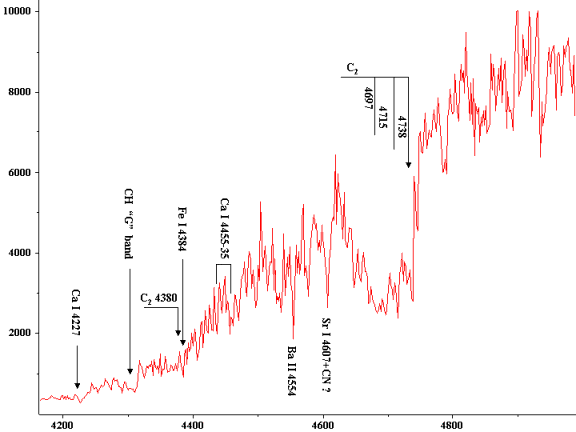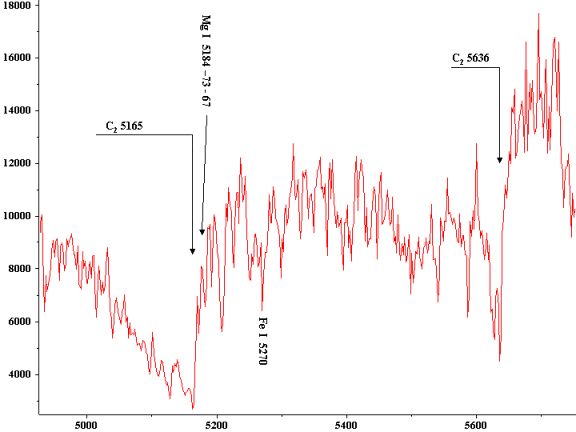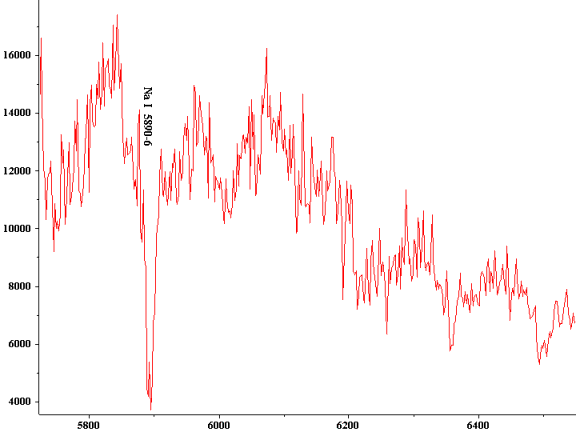PECULIAR STARS SPECTRA
Carbon stars (Type N)
The spectra of cold and reddish stars are interrupted by strong molecular absorbtion bands.
These bands come from simple molecules that can exist at high temperatures (2000 to 3000 K),
like the radicals C2, CN, CH, C3 and oxides CO, TiO, ZrO.
Depending on the availability of oxygen and carbon inside the stellar atmosphere,
the spectra can contain bands from different molecules and thus be very different from case to case.
In "normal" cold stars, that are collected in spectral class M, the TiO absorbtions are the strongest.
But when the ratio O/C decrease, then the bands originating from ZrO start to appear because Zirconium, althought
less aboundant, has a higher affinity for oxygen. In this case the star become an S star.
If the ratio O/C become even smaller, the metallic oxydes bands disappears and the visible spectrum
is filled with C2 bands. These are carbon stars and classified as N. All carbon stars are giants.
Since 1862 father Secchi was aware of the different shape of some banded spectra.
He introduced even a 4th class in his stellar spectra classification, in order to collect the red stars
that show bands with the head toward the red (as it happens for C2) while the 3rd class was for those
red stars with the bands head toward the blue(as it happens for TiO e ZrO).
Among the brigthest Carbon Stars we find:
U Cam (N5), R Lep (N6e), BL Ori (N0), UU Aur (N3), X Cnc (N3),
U Hya (N2), Y Cvn (N3), RY Dra (N4p), UX Dra (N0), TX Psc (N0).
In addition to the N traditional classification, it is nowadays widely used a classification
scheme that attributes to each carbon star a label in the form Cx,y.
The number x indicates the temperature (10 is for higher temperatures) and y indicates the carbon abundancy (10 is
for higher carbon content). As an example, TX Psc is classified as C7,2.
Carbon stars are very often long period variables.

|
Picture 1: Spectrum of 19 Piscium (TX Psc) recorded with 2 ┼ spectral resolution.
Bands from C2 with the "head" toward the red are found at 4738, 5165, 5636 ┼.
The spectrum is detailed in pictures 2-4.
Identification of absorbtion lines and bands is still incomplete because of the difficulty of
finding molecular lines databases for the visible region of the spectrum.
|

|
|
Picture 2: Spectrum of 19 Piscium between 4200 and 5000 ┼.
|

|
|
Picture 3: Spectrum of 19 Piscium between 4800 and 5700 ┼.
|

|
|
Picture 4: Spectrum of 19 Piscium between 5700 and 6500 ┼.
|
 Go Back to Home page of peculiar stars Go Back to Home page of peculiar stars
|
|
 Go Back to Home page of peculiar stars
Go Back to Home page of peculiar stars




